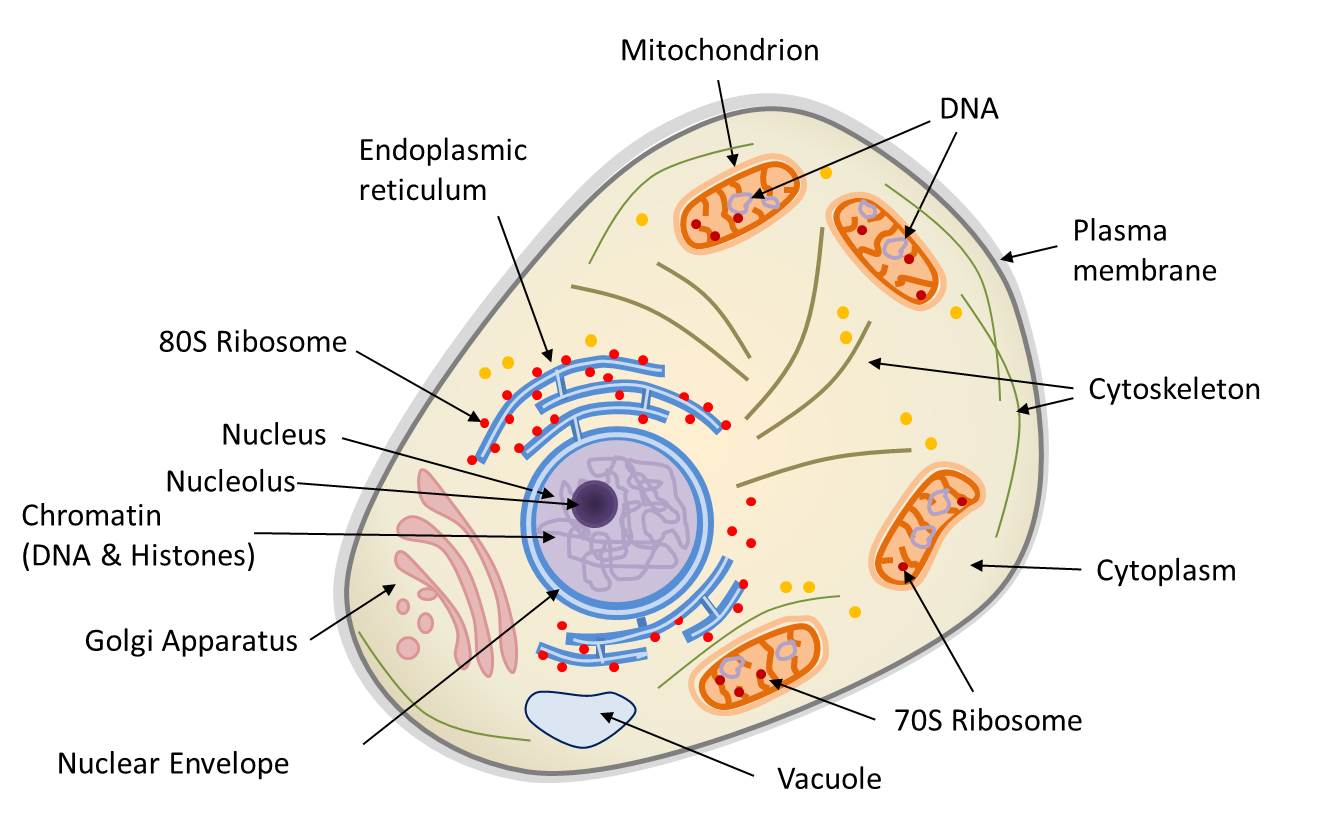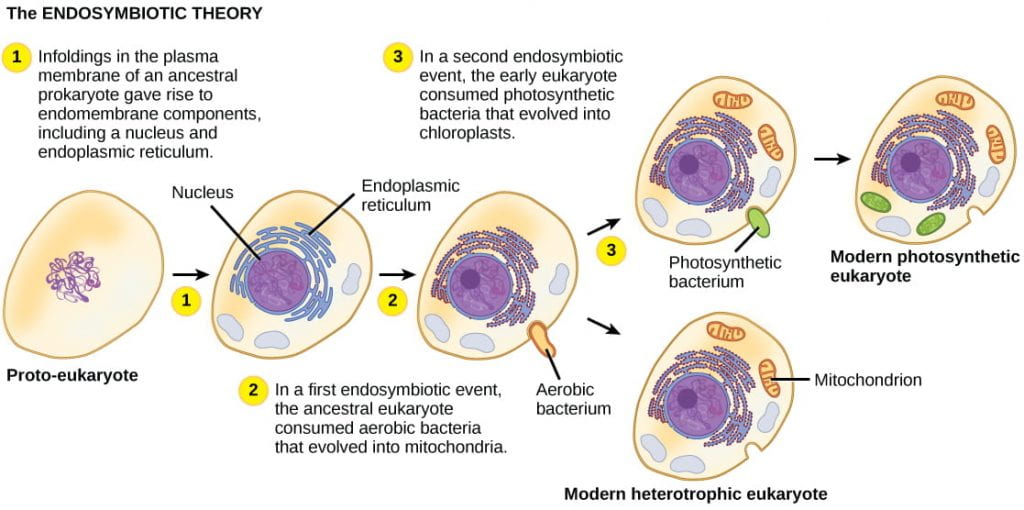Theory Used to Describe the Origin of Some Eukaryotic Organelles
Prevailing theory holds that eukaryotes came to be when a bacterium was swallowed by an archaeon. Up to 24 cash back c According to the endosymbiotic theory some organelles are believed to have evolved through a symbiotic relationship between eukaryotic and prokaryotic cells Author.
Eukaryotic cells boast their own personal power plants called mitochondria.

. The key difference between eukaryotic and prokaryotic cells is the presence or absence of a _____ and other membrane-bound organelles. Up to 10 cash back The Endosymbiotic Theory states that the mitochondria and chloroplast in eukaryotic cells were once aerobic bacteria prokaryote that were ingested by a large anaerobic bacteria prokaryote. Archaea Bacteria and Eukarya.
The _____ theory is used to describe the origin of some eukaryotic organelles. Jelly-like substance where chemical reactions take place the portion of the cell outside the nucleus _____3. North Salem Central School District Other titles.
Eukaryotic cells arose through endosymbiotic events that gave rise to the energy-producing organelles within the eukaryotic cells such as mitochondria and chloroplasts. User Last modified by. It predicted i all eukaryotes to possess mitochondria or to have secondarily lost them ii that the host for mitochondrial origins was an archaeon the eukaryotic state having arisen in the wake of mitochondrial origins and iii that.
Eukaryotic cells and microorganisms. The ________ theory is used to describe the origin of some eukaryotic organelles. Click card to see definition.
A In this so-called Three Domains scheme the two Eukaryotic and Archaea lines have the same origin each line being as old as the other. The _____ is a membrane-bound organelle derived from the Golgi that contains digestive enzymes and can provide protection. There is one alternative to classical endosymbiotic theory that took anaerobic mitochondria and hydrogenosomes into account the hydrogen hypothesis.
Endosymbiosis is the best explanation for the evolution of the eukaryotic cell. Up to 24 cash back Identify each eukaryotic organelle and describe its function. Whats more the evidence for endosymbiosis applies not only to mitochondria but to.
Organisms are classified into three domains. These tiny organelles in the cell not only produce chemical energy but also hold the key to understanding the evolution of the eukaryotic cell. The nuclear genome of eukaryotes is related most closely to the Archaea so it may have been an early archaean that engulfed a bacterial cell that evolved into a mitochondrion.
The _____ is the flexible molecular framework throughout the cytoplasm that anchors organelles and permits shape changes in some organisms. It predicted i all eukaryotes to possess mitochondria or to have secondarily lost them ii that the host for mitochondrial origins was an archaeon the eukaryotic state having arisen in the wake of. The _____ theory is used to describe the origin of some eukaryotic organelles.
Dan collea Created Date. Eukaryotic cells are more complex than prokaryotes and the DNA is linear and found within a nucleus. The engulfed bacterium the theory holds gave rise to mitochondria whereas internalized pieces of the outer cell membrane of the archaeon formed the cells other internal compartments including the nucleus and endomembrane system.
Based on decades of accumulated evidence the scientific community supports Marguliss ideas. The _________ theory is used to describe the origin of some eukaryotic organelles. This is explained by the endosymbiotic theory that explains the origin of eukaryotic cells by the prokaryotic organisms.
Up to 24 cash back and a short description of the function of that organelle. Tap again to see term. Condensed units within the nucleus that contain the genetic information.
Match the organelle with its function. Of the eukaryotic sub cellular structures listed. She is the one that pushed the theory of endosymbiosis even though idea of endosymbiosis has been around since around 1905 proposed by Konstantin Mereschkowski translation of 1905.
The first eukaryotic cells evolved about 2 billion years ago. 332016 125900 PM Company. Trematodes are also called_____.
A very sparse fossil record prevents us from determining what the first members of each of these lineages looked like so it is possible that all the events that led to the. She hypothesized that these two organelles were not originally internal components of a eukaryotic ancestor Read More Essay Ap Biology Study Reading Guide Chapter 6. There is one alternative to classical endosymbiotic theory that took anaerobic mitochondria and hydrogenosomes into account the hydrogen hypothesis.
Mitochondria and chloroplasts are eukaryotic organelles which have a number of features which suggest they are derived from eubacterial ancestors. Click again to see term. The first two lineages comprise all prokaryotic cells and the third contains all eukaryotes.
B The two-domain hypothesis comes from recent phylogenetic analyses. Tap card to see definition. In the endosymbiosis theory Lynn Margulis proposed the origin and evolution of the mitochondrion and the chloroplast two eukaryotic organelles Bergstrom and Dugatkin 2016.
Hypotheses for the origin of eukaryotes. Converts food energy into energy the cell can use ATP. This theory explains the origin of eukaryotic cells.
Mitochondria and chloroplasts are believed to have evolved from symbiotic bacteria. Learn vocabulary terms and more with flashcards games and other study tools. The cell ____ of fungi are rigid and provide structural support and shape to the cells.
Cornell Notes are a note-taking strategy in which topicquestions are written in a narrow left-hand column and definitions explanations and diagrams are filled in in the right-hand column. Used to synthesize lipids and to detoxify the cell _____2. They are similar in size to bacteria and they possess their own chromosomes which are circular like those of bacteria.
Endosymbiotic theory- the modern or organelle- containing eukaryotic cell evolved in steps through the stable incorporation of chemoorganotrophic and phototrophic symbionts from the domain Bacteria. One of the pioneers in research on eukaryotic origin is Lynn Margulis. The hypothesis of endosymbiosis is at present the most widely accepted theory on the evolution of the eukaryotic cell.

Cell Structure Definitions Cells Project Biology Cell Structure

Symbiosis And Evolution At The Origin Of The Eukaryotic Cell Encyclopedia Of The Environment


No comments for "Theory Used to Describe the Origin of Some Eukaryotic Organelles"
Post a Comment